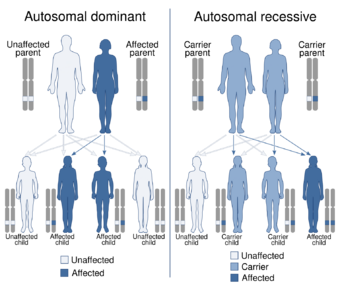Medicine:Spondylocamptodactyly
From HandWiki
| Spondylocamptodactyly | |
|---|---|
| Other names | Spondylocamptodactyly syndrome |
 | |
| It remains unclear whether this disorder is inherited in an autosomal dominant or autosomal recessive manner. | |
| Specialty | Medical genetics |
| Symptoms | Skeletal anomalies |
| Causes | Autosomal dominant/recessive with pseudodominance inheritance |
| Risk factors | unknown |
| Prevention | none |
| Prognosis | Good |
| Frequency | very rare, only 5 cases from a single 3-generation family have been reported. |
| Deaths | - |
Spondylocamptodactyly, also known as Spondylocamptodactyly syndrome, is a very rare multi-systemic genetic disorder which is characterized by the presence of camptodactyly, flattened vertebrae and thoracic scoliosis of varying degrees.[1][2] It has been described in 5 members of a 3-generation Mexican family,[3][4] It is thought to be inherited in an either autosomal dominant or autosomal recessive with pseudodominance pattern.[5][6]
References
- ↑ "Spondylocamptodactyly - About the Disease - Genetic and Rare Diseases Information Center" (in en). https://rarediseases.info.nih.gov/diseases/4972/spondylocamptodactyly.
- ↑ "Spondylocamptodactyly syndrome (Concept Id: C1838781) - MedGen - NCBI" (in en). https://www.ncbi.nlm.nih.gov/medgen/325510.
- ↑ "Spondylocamptodactyly Syndrome" (in en). http://www.dovemed.com/diseases-conditions/spondylocamptodactyly-syndrome/.
- ↑ Lizcano-Gil, L. A.; García-Cruz, D.; Sánchez-Corona, J.; Cantú, J. M. (October 1995). "Spondylo-camptodactyly syndrome: a distinct autosomal dominant entity?". Clinical Genetics 48 (4): 173–176. doi:10.1111/j.1399-0004.1995.tb04083.x. ISSN 0009-9163. PMID 8591666. https://pubmed.ncbi.nlm.nih.gov/8591666/.
- ↑ RESERVED, INSERM US14-- ALL RIGHTS. "Orphanet: Spondylocamptodactyly syndrome" (in en). https://www.orpha.net/consor/cgi-bin/OC_Exp.php?lng=EN&Expert=3180.
- ↑ "OMIM Entry - 600000 - SPONDYLOCAMPTODACTYLY" (in en-us). https://omim.org/entry/600000#1.
 |

